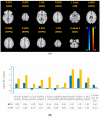Intrinsic Network Changes in Bilateral Tinnitus Patients with Cognitive Impairment: A Resting-State Functional MRI Study
- PMID: 36009112
- PMCID: PMC9405767
- DOI: 10.3390/brainsci12081049
Intrinsic Network Changes in Bilateral Tinnitus Patients with Cognitive Impairment: A Resting-State Functional MRI Study
Abstract
Previous studies have found a link between tinnitus and cognitive impairment, even leading to dementia. However, the mechanisms underlying this association are not clear. The purpose of this study was to explore intrinsic network changes in tinnitus and hearing loss patients with cognitive disorders. We included 17 individuals with bilateral idiopathic tinnitus, hearing loss, and cognitive impairment (PA) and 21 healthy controls. We identified resting-state networks (RSNs) and measured intra-network functional connectivity (FC) values via independent component analysis (ICA). We also evaluated correlations between RSNs and clinical characteristics. Compared with the healthy controls, the PA group showed decreased connectivity within the ventral attention network, dorsal attention network (DAN), visual network, left frontoparietal network, right frontoparietal network, sensorimotor network, and increased connectivity within the executive control network. MoCA (Montreal Cognitive Assessment) scores were negatively correlated with the FC values for left calcarine within the DAN. We identified abnormal intrinsic connectivity in several brain networks, mainly involving cognitive control, vision, sensorimotor function, and the cerebellum, in tinnitus patients with cognitive impairment. It may be possible to use the FC strength of the left calcarine within the DAN as an imaging marker to predict cognitive impairment in tinnitus patients.
Keywords: cognitive impairment; functional connectivity; hearing loss; independent component analysis; resting state functional magnetic resonance imaging; tinnitus.
Conflict of interest statement
The authors declare no conflict of interest.
Figures




References
LinkOut - more resources
Full Text Sources
Miscellaneous

